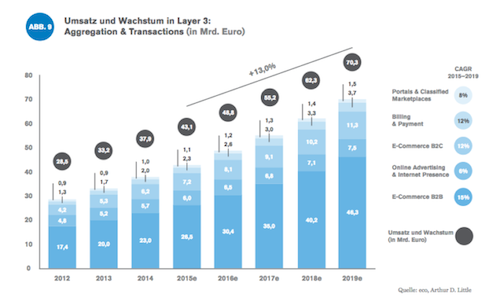How digitization is fundamentally changing business models of industries
Digitalisation is not only having a massive impact on the B2C world, but is also a sign of radical change in B2B sales. B2B companies must adapt to this new environment and place the customer at the centre of sales activities - because B2B business models will in future be determined by the end customer.

B2C sets the standard for B2B
New technologies, increasing competition from the B2C sector and changing customer requirements will blur the boundaries between B2B and B2C more and more in the future.
1. Increasing customer demands
The so-called millenials are the new decision-makers on the customer side. In the USA, 46 percent of B2B decision-makers are already under the age of 35, and the picture is similar in Germany. Buyers research online and also want to make purchases quickly and conveniently online. So when the B2B buyer is looking for a product or service in the business segment, he expects the performance he knows from the B2C market. According to a study conducted by Forrester Research in 2017, around three quarters of all B2B buyers surveyed would find procurement via the Internet much more convenient. They expect their suppliers to provide them with ordering options such as Amazon in the future.
2. Higher procurement competence
In connection with digitization, the procurement processes of B2B customers have also changed. Customers are expanding their procurement competence and consistently using their purchasing power to their advantage. For example, the use of the Internet has increased significantly in the information procurement phase. According to studies, 90 percent of B2B buyers look for keywords on the Internet, 70 percent watch videos to find out more before making a purchase. 57 percent of the purchasing process has already been completed when a sales employee is contacted for the first time.
3. Growing competition
New digital players, mostly from the B2C business, are entering the market and putting traditional B2B companies under increasing pressure with new offers and unconventional business models. They use their B2C experience and operate with innovative business models, for example as online only distributors or as aggregators of offers (e.g. Who delivers what?). These include players such as Amazon and Alibaba, who are entering the market at high speed, with new technologies and enormous resources, and are redefining entire branches of industry at a rapid pace.
4. Fast pace
Increasing competition leads to a greater variety and complexity of products while at the same time shortening product life cycles. The demands on speed, flexibility and transparency of companies and their supply chains are increasing. B2B companies whose sales activities are not geared to this fast pace are coming under increasing pressure.
5. New Technologies
Increasingly, functions of a product are no longer realized by hardware, but by software within the product. The requirements from software sales are added to the requirements from B2B sales of physical products. In addition, disruptive or improved technologies are conquering the market faster and faster (e.g. adoption time telephone vs. Facebook). In the digital world, it is often no longer enough to just develop good products. The sales department must be able to react flexibly to this.
Enormous potential for digital B2B sales
According to current calculations by management consultants Arthur D. Little, B2B e-commerce in Germany is currently growing at an annual rate of 15 percent. However, this potential is still not being used by many companies, or hardly used at all. Most B2B companies invest only a small portion of their marketing and sales budgets in digital channels. They increase their internal cost and process efficiency by digitizing back-office workflows and resource planning as well as modernizing existing IT architectures. However, the greatest potential lies in the digitization of sales.

Human digital strategy
A recent survey of B2B customers conducted by McKinsey showed that customers want both digital interactions and direct human contact. According to the study, speed, transparency and expertise should also be key elements of a successful human digital strategy. B2B sales managers who implement this approach would generate up to five times the growth of their colleagues. The fastest growing companies are using advanced analytics and tools to improve their sales productivity.
3 Priorities for Sales Transformation
If B2B executives want to advance digitization in marketing and sales organizations, three implementation factors in particular are essential:
1. Documentation of the Customer Journey
In order to find out what the expectations and needs of potential and existing customers are, the customer journey must be documented. With the help of automated systems and data from existing data sources (customer surveys, complaint management, Google Analytics, etc.), concretely defined customer segments or buyer personas can be derived that enable a sales process tailored to the customer.
2. Reassign sales and marketing resources
Once companies record customer journeys, they often realize that traditional sales practices misallocate resources. For example, one OEM found that 70 percent of the budget was not focused on what was most important to customers. The company had invested heavily in custom plant demos. However, more than half of the customer base had no interest and was satisfied with a standard demo kit. Sales and marketing resources should therefore be deployed where they have the greatest impact on purchasing decisions. Often this is accompanied by the need to create a new corporate culture, as experienced executives and sales managers often find it difficult to accept the reality that long-standing "truths" no longer apply.
3. Change in the organizational structure
In addition to the corporate culture, the reorganization of sales usually requires a change in the organizational structure in order to improve cooperation between marketing and sales. For a B2B salesperson, for example, data from marketing analyses showed that leads for small and medium-sized businesses were converted into product sales at higher rates when telephone calls or direct mail had already preceded email interactions. The customer relationship management system was adapted accordingly.
Conclusion: High growth opportunities through digital B2B sales
Digital technologies are leading to massive changes in business and industrial customer sales and at the same time offer great opportunities to stand out from the competition. By investing in targeted digital capabilities, B2B companies can dramatically improve their financial performance. It is therefore better for companies today than tomorrow to consider how they will align their business models in the future.











